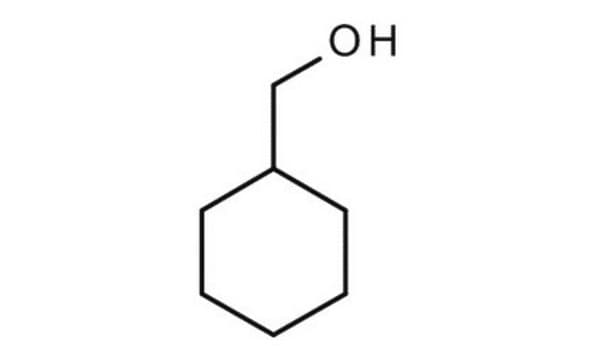09143
Benzaldehyde
analytical standard
Synonym(s):
Bitter almond
About This Item
Recommended Products
grade
analytical standard
Quality Level
vapor density
3.7 (vs air)
vapor pressure
4 mmHg ( 45 °C)
Assay
≥99.5% (GC)
form
liquid
autoignition temp.
374 °F
shelf life
limited shelf life, expiry date on the label
expl. lim.
1.4 %, 20 °F
technique(s)
HPLC: suitable
gas chromatography (GC): suitable
refractive index
n20/D 1.545 (lit.)
n20/D 1.546
bp
178-179 °C (lit.)
mp
−26 °C (lit.)
density
1.044 g/cm3 at 20 °C (lit.)
application(s)
cleaning products
cosmetics
environmental
flavors and fragrances
food and beverages
personal care
format
neat
SMILES string
O=Cc1ccccc1
InChI
1S/C7H6O/c8-6-7-4-2-1-3-5-7/h1-6H
InChI key
HUMNYLRZRPPJDN-UHFFFAOYSA-N
Looking for similar products? Visit Product Comparison Guide
Related Categories
General description
Find all available reference materials for compounds listed in 10/2011 here
Application
Signal Word
Danger
Hazard Statements
Precautionary Statements
Hazard Classifications
Acute Tox. 4 Inhalation - Acute Tox. 4 Oral - Aquatic Chronic 2 - Eye Irrit. 2 - Repr. 1B - Skin Irrit. 2 - STOT SE 3
Target Organs
Respiratory system
Storage Class Code
6.1C - Combustible acute toxic Cat.3 / toxic compounds or compounds which causing chronic effects
WGK
WGK 1
Flash Point(F)
145.4 °F - closed cup
Flash Point(C)
63 °C - closed cup
Personal Protective Equipment
Regulatory Listings
Regulatory Listings are mainly provided for chemical products. Only limited information can be provided here for non-chemical products. No entry means none of the components are listed. It is the user’s obligation to ensure the safe and legal use of the product.
PRTR
Class I Designated Chemical Substances
FSL
Group 4: Flammable liquids
Type 2 petroleums
Hazardous rank III
Water insoluble liquid
ISHL Indicated Name
Substances Subject to be Indicated Names
ISHL Notified Names
Substances Subject to be Notified Names
JAN Code
09143-BULK-F:
09143-VAR-F:
09143-25ML-F:
09143-5ML-F:
Choose from one of the most recent versions:
Already Own This Product?
Find documentation for the products that you have recently purchased in the Document Library.
Customers Also Viewed
Protocols
-Tolualdehyde; Valeraldehyde; Isovaleraldehyde
Our team of scientists has experience in all areas of research including Life Science, Material Science, Chemical Synthesis, Chromatography, Analytical and many others.
Contact Technical Service














